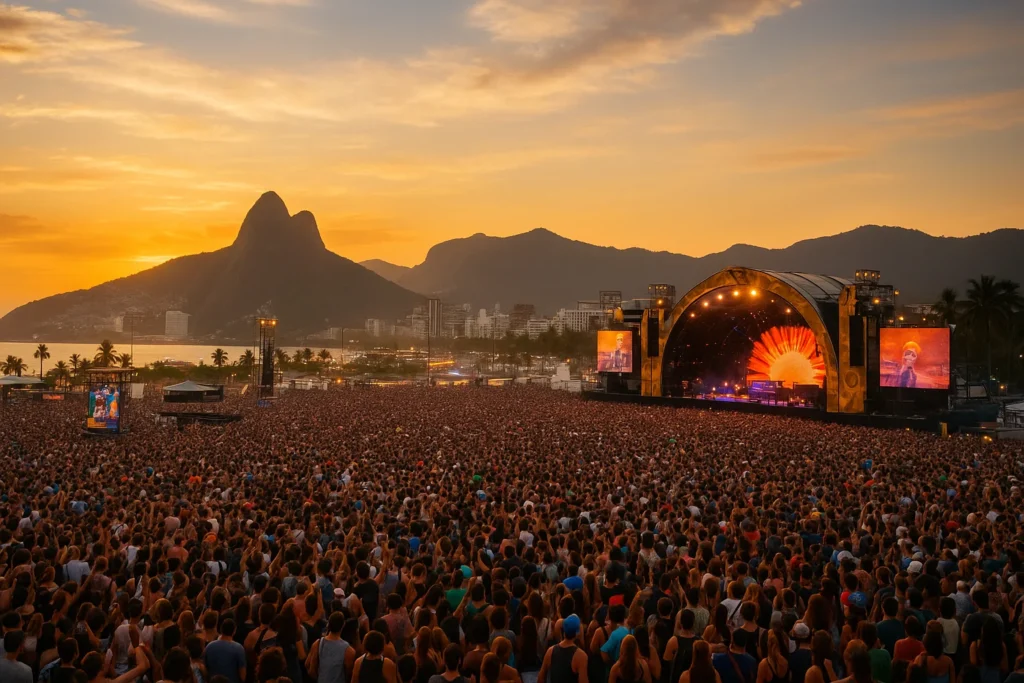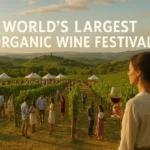The air in Rio de Janeiro always carries a special kind of rhythm. It’s a soulful blend of the salty breeze from the Atlantic, the happy chatter of the local Cariocas, and the distant, constant beat of a samba school rehearsing in a nearby favela. But for five glorious days, this natural, local rhythm was joined by a colossal new heartbeat—the synchronized pulse of over 1.5 million people, all moving as one. This was the unprecedented sound of the world’s largest open-air music festival, an event that didn’t just break records but redefined what a festival could be.
This wasn’t just a series of concerts; it was a living, breathing city within a city. A sprawling, vibrant masterpiece of sound, color, and human connection that wove its way through Rio’s most iconic landscapes. From the golden sands of Copacabana to the verdant expanse of Flamengo Park, the festival didn’t just happen in Rio—it became Rio. It was a cultural and sensory takeover, a temporary reality where the line between audience and performer, and between the city and the event, completely blurred.
The Genesis of a Global Phenomenon: From Vision to Reality
The story of this unprecedented event began not five days, but five years earlier, when a visionary group of Brazilian cultural ministers, music producers, and urban planners first conceived of creating something never before attempted. Their ambitious goal was to create not just another music festival, but the world’s largest cultural gathering—one that would leverage Rio’s entire urban landscape as its stage. The planning process involved unprecedented coordination between city departments, environmental agencies, community leaders, and international event specialists.
Early challenges seemed insurmountable: How would they manage sound pollution across such a vast area? How could they ensure public safety for crowds that would exceed the population of many cities? How would they transport millions of people without paralyzing Rio’s infrastructure? The solutions emerged through innovative thinking and cutting-edge technology. Advanced sound modeling software ensured that different musical zones wouldn’t interfere with each other or disrupt residential areas too severely. A sophisticated crowd management system using artificial intelligence and real-time monitoring was developed to track movement patterns and prevent dangerous congestion.
The selection of Rio as the host city was no accident. Its natural amphitheaters—from the sweeping bays to the mountainous terrain—provided perfect acoustic environments. Its cultural history as a melting pot of musical traditions made it the ideal symbolic home for a global music celebration. And its established infrastructure from previous major events like the World Cup and Olympics provided a foundation to build upon, though everything would need to be scaled up dramatically.
The Grand Opening: A Ceremony for the History Books
The festival commenced with an opening ceremony that would be remembered for generations. As twilight settled over the city, a single, pure note from a conch shell blown by an elder of the Pataxó indigenous community echoed across Copacabana Beach. This solitary sound was answered by the deep resonance of a Tibetan singing bowl from a stage in the Botanical Gardens, then by the haunting call of a didgeridoo from an Australian artist in Lapa, followed by the spiritual chanting of a Mongolian throat singer in Flamengo Park.
One by one, from every corner of the city, distinctive cultural sounds joined this growing symphony—the complex rhythms of West African drumming, the elegant strains of a European classical violin, the futuristic tones of a Japanese electronic instrument. This auditory wave swept across Rio, building to a crescendo that culminated in all performers and audiences falling silent simultaneously, followed by an explosive cheer that seemed to shake the very foundations of the city. This breathtaking opening, streamed live to over 50 million viewers worldwide, immediately established the festival as something transcendent—a true meeting of world cultures through the universal language of music.
A Stage Without Walls: The Revolutionary City-Wide Venue Concept
The festival’s revolutionary approach rejected the traditional confined venue model in favor of what organizers called the “City-Scape Soundscape”—turning all of Rio into an immersive musical experience. The city was divided into seven distinct musical zones, each with its own personality and carefully curated lineup:
The Pantheon of Beats (Copacabana Beach) utilized the vast expanse of the world’s most famous beach for its main stage, engineered to float just offshore with performers backed by the spectacular ocean sunset. The sound system was specially calibrated to carry clearly over water without excessive bleed into residential areas.
The Sonic Forest (Tijuca National Park) offered a completely different experience deep within the world’s largest urban rainforest. Stages built around ancient trees featured ambient electronic, world folk, and acoustic performances where nature itself became part of the show, with minimal lighting to preserve the magical forest atmosphere.
The Lapa Arches Circuit (Historic Downtown) tapped directly into Rio’s musical soul around the iconic Arcos da Lapa aqueduct. This area pulsed with non-stop samba, pagode, forró, and axé music, with impromptu rodas de samba (samba circles) erupting spontaneously throughout the neighborhood’s cobblestone streets.
The Flamengo Park Groove provided a family-friendly zone along Guanabara Bay with sloping lawns perfect for picnicking while enjoying rock, pop, and indie acts. This area also hosted the massive “Global Bazaar” marketplace featuring artisans and foods from around the world.
The Santa Teresa Vista accessible by the famous bonde (tram) offered intimate performances in theaters, galleries, and panoramic terraces featuring jazz, bossa nova, and classical music that attracted more discerning listeners.
The Olympic Park Hub in Barra da Tijuca utilized existing Olympic infrastructure for massive-scale EDM, hip-hop, and pop events with staggering production values and state-of-the-art technology.
The Niterói Cross-Bay Experience extended the festival across Guanabara Bay via a dedicated ferry fleet, with a main stage set against the stunning architecture of the Museu de Arte Contemporânea offering breathtaking views of the Rio skyline.
This decentralized model allowed attendees to become urban explorers on a musical journey, with a fleet of zero-emission shuttle buses, an expanded 24-hour metro system, and a sophisticated festival app helping navigate between zones seamlessly.
The Economic Symphony: Transforming Rio’s Economy
The financial impact of the festival on Rio de Janeiro was profound and multi-layered, creating benefits that extended far beyond the five-day event itself:
The hospitality industry experienced an unprecedented boom, with hotels across all neighborhoods reporting 98% occupancy rates months in advance. The city’s “Casa Carioca” program enabled residents to rent rooms directly to visitors, injecting tourism dollars straight into local households. Restaurants saw revenues triple as famed churrascarias (steak houses) had lines around the block while small family-owned botecos introduced international visitors to authentic Brazilian cuisine.
Local artisans and micro-entrepreneurs found a global platform through the official “Feira Harmonia” marketplace, which featured over a thousand carefully selected vendors. Jewelers inspired by Amazonian flora, clothing designers showcasing Afro-Brazilian prints, and instrument makers demonstrating handmade cavaquinhos and pandeiros found eager international customers, with many generating enough capital to launch or expand formal businesses.
The festival’s economic impact extended to infrastructure improvements negotiated as part of the hosting agreement. A significant portion of revenue was reinvested in permanent city benefits including new electric buses for public transit, renovations in the historic port district, and solar panel installations on municipal buildings. This created a legacy of improved services and sustainability that would benefit residents for years to come.
The event also created employment for over 50,000 people in roles ranging from security and medical staff to translators, sustainability guides, and tech support. For thousands of students and young professionals, the festival provided valuable international work experience and resume-building opportunities that extended far beyond the event itself.
A Mosaic of Sound: The Curated Global Musical Experience
The artistic curation represented a monumental achievement in cultural programming, featuring over 500 official performances from artists representing 40 countries while maintaining a strong foundation in Brazilian musical heritage:
The lineup naturally included global superstars—a legendary British rock band’s final South American performance, a Korean pop phenomenon drawing a crowd visible from space, and a Nigerian Afrobeat icon whose polyrhythms set the beach ablaze with energy. But the true magic often happened in the unexpected “secret sets” that became festival legend—a beloved indie folk singer appearing for a solo acoustic performance in the Sonic Forest, with word spreading like wildfire through the festival app.
The “Cultural Crossroads” program formed the intellectual heart of the festival, with stages dedicated to thematic explorations like “The African Diaspora in Sound,” which traced musical lineages from traditional West African drumming through Brazilian maracatu, Cuban rumba, and American jazz. Another program, “Strings of the World,” featured virtuosos of the Japanese koto, Paraguayan harp, Indian sitar, and American bluegrass banjo in conversation, culminating in unprecedented collaborative performances.
While global in scope, the festival remained deeply rooted in celebrating Brazil’s astonishing musical diversity. Beyond the familiar samba and bossa nova, stages dedicated to tecnobrega from the North, sertanejo from the Central-West, and the electronic funk carioca born in Rio’s own favelas showcased the full spectrum of the nation’s homegrown talent. This provided both international education and immense local pride, validating Brazil’s complete musical heritage on a world stage.
Harmony with the Planet: Establishing the Green Standard for Mega-Events
The festival established new environmental benchmarks for large-scale events, treating sustainability not as an add-on but as a core design principle integrated into every aspect of planning and execution:
The comprehensive waste management system achieved remarkable results. Every attendee received a festival kit including reusable aluminum bottles, collapsible cups, and bamboo cutlery. Over 500 water stations offered free filtered water throughout the venues. A team of “Eco-ambassadors” patrolled with mobile charging stations that rewarded proper waste sorting with phone charging. The result was an unprecedented 89% diversion of waste from landfills, with composting facilities established for the event becoming permanent city resources.
The renewable energy infrastructure represented a monumental engineering achievement. The main offshore stage at Copacabana was powered by solar arrays on barges, hydrogen fuel cells, and kinetic energy harvested from pressure-sensitive dance floors. Stages in Tijuca Forest utilized small hydroelectric turbines in streams and discreet solar panels. The entire event’s carbon footprint was calculated in real-time, with ticket revenue funding verified carbon offset programs that protected designated areas of the Amazon rainforest, making the festival carbon-negative overall.
The environmental commitment extended to social and biological responsibility. Formal agreements with communities surrounding venues ensured minimal disruption and maximum benefit. Biologists monitored impact on wildlife in Tijuca Forest, with pathways designed to protect fragile ecosystems. Food vendors were required to source significant ingredients from local organic farms, reducing food miles while supporting regional agriculture.
The Infrastructure of Joy: Mastering Unprecedented Logistics
The seamless experience enjoyed by attendees masked a military-precision logistical operation years in the making:
Rio’s metro system became the event’s backbone, running on a 24-hour schedule with trains arriving every two minutes during peak times. A dedicated festival pass allowed unlimited travel across the system. Hundreds of electric and biodiesel buses serviced connecting routes, while a massive bike-sharing program with protected lanes offered alternative transportation. Traffic flow was managed by an AI-powered command center that adjusted signals in real-time to optimize movement throughout the city.
Security was omnipresent but intentionally unobtrusive, built on a foundation of thousands of highly trained, multilingual stewards focused on customer service and de-escalation. An extensive network of medical tents was staffed with professionals trained in crowd medicine, with mental health professionals available at “Sanctuary” tents for those overwhelmed by the sensory experience. This comprehensive safety net ensured that the massive crowds remained peaceful and secure throughout the event.
The festival’s digital infrastructure was equally impressive. The dedicated app offered real-time crowd analytics, schedule updates, a “musical compatibility” feature suggesting stages based on listening preferences, and a “Friend Finder” that worked even with limited service. It also served as a vital emergency alert system, ensuring that even amidst millions of people, no one needed to feel lost or disconnected.
The Human Tapestry: Stories That Defined the Experience
Beyond the impressive statistics and logistical achievements, the true magic of the festival emerged in the countless human connections it fostered:
There was the elderly Japanese jazz enthusiast who had saved for decades to attend, standing silently with tears streaming down his face as his hero, a Brazilian pianist he had only ever heard on vinyl, performed mere feet away. The pianist noticed him, came down after the set, and embraced him—a moment captured by a photographer and celebrated worldwide as the “photo of the festival.”
There was the group of university students from Egypt, India, Mexico, and Canada who became inseparable after bonding over their shared love for an obscure Icelandic post-rock band. They navigated the entire festival together, their friendship embodying the event’s mission of global unity across cultural boundaries.
There was the local favela community that organized pre-festival clean-ups and then worked proudly as stewards, guiding visitors with infectious pride in their city. For them, the festival represented an opportunity to showcase the positive spirit of communities often misrepresented in media coverage.
These micro-stories of connection, friendship, and shared wonder became the festival’s true currency, demonstrating that the ambitious vision had succeeded in its deepest purpose—forging human connections through shared experience.
The Final Chord and Lasting Echo: A Legacy Forged in Rhythm
As the final collaborative performance featuring dozens of artists from across genres and cultures played its last fading note, a hush fell over the city—not of emptiness, but of satiated joy and collective exhaustion. The remarkably efficient cleanup began immediately, with the city’s beaches and parks returning to their pristine state within 48 hours, a testament to the effectiveness of the sustainability initiatives.
The legacy of the festival extends far beyond those five days. It provided Rio with both an immediate economic stimulus and long-term infrastructure improvements that would benefit residents for years. It enhanced the city’s global reputation as a capable host for the world’s most complex events while showcasing its cultural richness beyond stereotypes.
Environmentally, it established a scalable, replicable blueprint for staging mega-events without ecological sacrifice, influencing event planning worldwide. Psychologically, it gave Rio’s residents a profound sense of pride in their city’s capacity for beauty, organization, and warm hospitality.
Most importantly, it provided the world with a powerful, tangible demonstration of global unity through culture. In an era of division, the festival stood as proof that our common language of rhythm, melody, and harmony can bridge any divide. The music may have stopped, but the echo of those five days in Rio—the proof that a different world is possible—continues to resonate, inspiring a new generation to build bridges where others would build walls.




Your articles never fail to captivate me. Each one is a testament to your expertise and dedication to your craft. Thank you for sharing your wisdom with the world.
Your writing is like a breath of fresh air in the often stale world of online content. Your unique perspective and engaging style set you apart from the crowd. Thank you for sharing your talents with us.
Somebody essentially lend a hand to make significantly posts I might state That is the very first time I frequented your web page and up to now I surprised with the research you made to create this particular put up amazing Excellent job
My brother suggested I might like this website He was totally right This post actually made my day You cannt imagine just how much time I had spent for this information Thanks
My brother recommended I might like this web site He was totally right This post actually made my day You cannt imagine just how much time I had spent for this information Thanks
What i do not understood is in truth how you are not actually a lot more smartlyliked than you may be now You are very intelligent You realize therefore significantly in the case of this topic produced me individually imagine it from numerous numerous angles Its like men and women dont seem to be fascinated until it is one thing to do with Woman gaga Your own stuffs nice All the time care for it up
Your blog is a treasure trove of knowledge! I’m constantly amazed by the depth of your insights and the clarity of your writing. Keep up the phenomenal work!